#mbiresaurus
Explore tagged Tumblr posts
Text

Mbiresaurus remake
3 notes
·
View notes
Text
Round Three: Mbiresaurus vs Kholumalumo
Mbiresaurus raathi
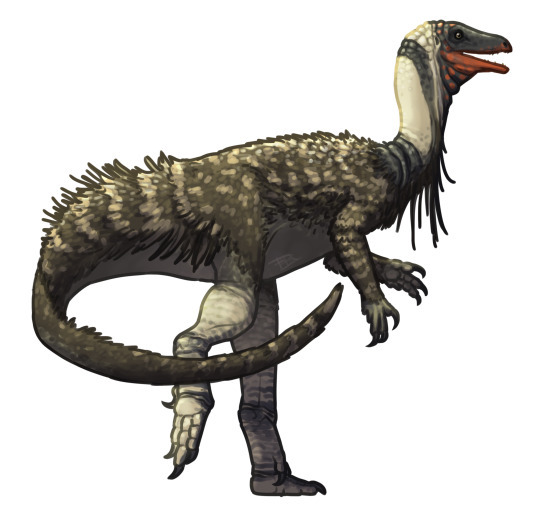
Artwork by @i-draws-dinosaurs, written by @i-draws-dinosaurs
Name meaning: Raath’s reptile from Mbire (after the Mbire district of Zimbabwe, and in honour of palaeontologist and discoverer Michael Raath)
Time: ~ 230 million years ago (Carnian stage of the Late Triassic)
Location: Pebbly Arkose Formation, Zimbabwe
There was once a time… before titanosaurs… before diplodocids… before any sauropod… when sauropodomorphs were simply Just Some Little Guy. And that is where Mbiresaurus, oldest African dinosaur ever found, comes in!
Mbiresaurus was named in 2022 from Zimbabwe, and is the only dinosaur yet named from the Pebbly Arkose formation. It’s known from a beautifully complete skeleton that has all the features of a classic Early Dinosaur. It is small, has long gangly legs and arms, and a lil head with vaguely pointy kinda multipurpose teeth. The fact that all the wild diversity and enormous size of the sauropods came out of something like this is hard to imagine, but evolutionarily step by step these little scampery dudes would work their way up!
Kholumolumo ellenbergerorum

Artwork by @alphynix, written by @i-draws-dinosaurs
Name meaning: Kholumolumo (giant reptilian dragon from Sotho folklore) named for Paul and François Ellenberger (the original excavators of the fossils)
Time: 210 million years ago (Norian stage of the Late Triassic)
Location: Lower Elliot Formation, Lesotho
Kholumolumo is an old friend with a new name. Its previous informal name, “Thotobolosaurus” meaning “trash heap reptile”, was truly magnificent and became one of the great memes of Ye Olde 2010s Palaeo Tumblr! Needless to say it was a bittersweet moment to see our old buddy finally published but lose its iconic name in the process. Rest in peace, Trash Heap Lizard.
The reason it wound up with that name is because the fossils were in fact found basically right next to the local rubbish dump of the village of Maphutseng in 1955. The trash pile turned out to be sitting on a bone bed of around five to ten animals, and over the course of several years they were excavated and moved to the University of Cape Town. Unfortunately, and perhaps appropriately to the name, the subsequent study of these fossils ended up being a complete trash fire. Specimens went missing that have never been found, professional relationships fell apart, and the animal itself wasn’t mentioned in the literature until 1970 when it was dropped into a discussion on the stratigraphy of the Elliot formation and named “Thotobolosaurus mabeatae” without any description of the fossils. This made the name “Thotobolosaurus” a nomen nudum (naked name) and thus invalid.
Finally in 2020 all the tribulation paid off and it received a proper initial description, although many fossils that weren’t lost in the chaos still remain under study and could be the subject of future papers. It’s nice to see our beloved trash heap of a dinosaur finally coming into its own!
#dmm#dmm rising stars#dinosaur march madness#dinosaurs#birds#palaeoblr#birblr#paleontology#march madness#polls#bracket#mbiresaurus#kholumalumo#round three
107 notes
·
View notes
Text

DINOVEMBER 2/13: Musankwa sanyatiensis
No.2, finally. On the 7th. This is why I didn't give myself one every day folks.
This sauropodomorph was discovered near the top of Zimbabwe's Pebbly Arkose formation, dating back to around 225Ma ago. The description of the specimen, a partial leg bone, was published in May of this year by Barrett et al. It's nothing too special morphology and phylogeny wise, falling slap bang halfway between the most basal sauropodomorphs (like its compatriot Mbiresaurus) and the sauropods proper. It doesn't appear to be particularly large or small for a "prosauropod", but it's nice to have another Triassic species and an addition to the poorly studied palaeofauna of Africa. Even if the lead scientist on the paper was one of the European scientists working on the specimen and not the Zimbabwean ones. A bit yikes.
I decided to give this male some neck quills, I love a sauropodomorph neck quill, and a funky throat patch as well. I also tried to give him a dynamic pose but it didn't work out for me, so I did a more standard side shot.
#palaeostuff#anthem posts#anthems art#Musankwa#triassic#palaeontology#palaeoart#palaeoblr#paleontology#paleoart#dinovember#dinovember 2024#dinosaurs#sauropodomorpha#n class
65 notes
·
View notes
Text
Musankwa sanyatiensis Barrett et al., 2024 (new genus and species)
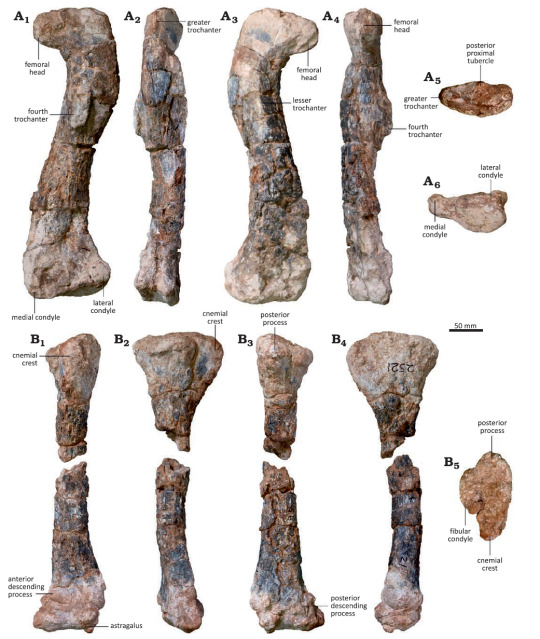
(Type specimen of Musankwa sanyatiensis, from Barrett et al., 2024)
Meaning of name: Musankwa = Musankwa [name of houseboat that researchers stayed at during field expeditions to the site where the original fossil was found]; sanyatiensis = from the Sanyati River
Age: Late Triassic (Norian)
Where found: Pebbly Arkose Formation, Mashonaland West, Zimbabwe
How much is known: A partial right hindlimb.
Notes: Musankwa was an early sauropodomorph. Although sauropodomorphs famously include the often gigantic quadrupedal sauropods, early members of this group were primarily bipedal. Compared to Mbiresaurus, a slightly older sauropodomorph also known from the Pebbly Arkose Formation, Musankwa appears to have been more closely related to true sauropods.
Reference: Barrett, P.M., K.E.J. Chapelle, L. Sciscio, T.J. Broderick, M. Zondo, D. Munyikwa, and J.N. Choiniere. 2024. A new Late Triassic sauropodomorph dinosaur from the Mid-Zambezi Basin, Zimbabwe. Acta Palaeontologica Polonica 69: 227–241. doi: 10.4202/app.01100.2023
110 notes
·
View notes
Text
Long-necked herbivorous dinosaurs are known as sauropodomorphs. They were a group of mainly bipedal dinosaurs that lived some 210 million years ago in the Late Triassic. Kimberley (Kimi) Chapelle, assistant professor in the anatomical sciences department in the Renaissance School of Medicine at Stony Brook University, is part of the international team of scientists that discovered and identified the find, named Musankwa sanyatiensis. The discovery of Musankwa sanyatiensis is particularly significant as it is the first dinosaur to be named from the Mid-Zambezi Basin of northern Zimbabwe in more than 50 years. The fossil follows only these previous dinosaur discoveries in the region: Syntarsus rhodesiensis in 1969, Vulcanodon karibaensis in 1972, and Mbiresaurus raathi in 2022.
Continue Reading.
78 notes
·
View notes
Photo

New dinosaur alert! Presenting Mbiresaurus raathi
Image ID: A digital illustration of the early sauropodomorph dinosaur Mbiresaurus. It is a slender, two-legged dinosaur with a long neck and tail and a body covered in fluffy feathers. The feathers are brown with lighter speckles that turn into stripes on the tail. The head and neck are wrinkled and featherless except for a few long feathers that hang from the base of the neck. The head and neck are coloured with patches of black and white, and an orange lower jaw. The Mbiresaurus is posed in a rough three-quarter view, facing to the right and away from the viewer. The neck is upright and alert, the mouth is slightly open, one foot is raised off the ground and the tail is curved around in front of its legs. End ID.
A newly-described species from Zimbabwe, Mbiresaurus is now the oldest named dinosaur species from Africa! It’s an early sauropodomorph, related to dinosaurs like Eoraptor and Buriolestes, and was probably an omnivore.
Mbiresaurus comes from a new fossil site in Zimbabwe, which contains a whole lot of other species that have yet to be described, including a herrerasaurid, which I’ve represented in this size diagram with Staurikosaurus.
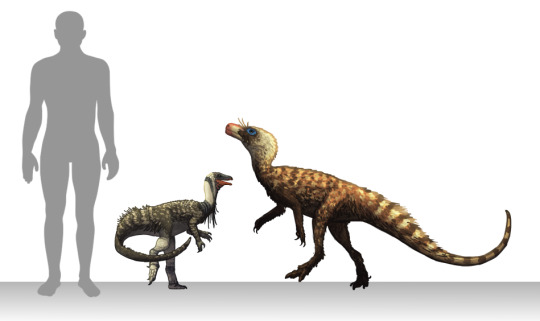
Image ID: A size chart showing Mbiresaurus and the early carnivorous dinosaur Staurikosaurus next to a light grey silhouette of a person. The Mbiresaurus’ head is level with the person’s upper thigh, and the Staurikosaurus’ head comes to approximately waist height. End ID.
The formation also includes a number of synapsid species, a rhynchosaur, and an aetosaur, a group of armoured herbivorous crocodile relatives that had never been found in southern Africa before! When combined together into Pangaea, the location of the fossil site matches the latitude of other Late Triassic early dinosaur sites, suggesting that dinosaurs and other Late Triassic species initially migrated across a similar climatic band that would eventually become South America and southern Africa.
#dinosaurs#paleoart#paleontology#new dinosaur#palaeoblr#mbiresaurus#sauropodomorph#triassic#fossils#prehistoric
594 notes
·
View notes
Photo

Hi there!
My take on the Mbiresaurus raathi, the new and oldest dinosaur from Africa
21 notes
·
View notes
Photo

‘I’ve got a dinosaur!’ African find illuminates dawn of dinos
230 million years ago, the earliest dinosaurs thrived in mild climates
During the late Triassic period, when the terrestrial world was a single sprawling land mass called Pangaea, a dog-size plant-eating dinosaur perished near a river in the southern part of the continent. When the river flooded, its body was buried by sediment, with some bones still articulated as in life.
About 230 million years later, paleontologist Chris Griffin, then a doctoral student at the Virginia Polytechnic Institute and State University, spotted a thigh bone sticking out of a hill in the Cabora Bassa River Basin in what is now Zimbabwe. “I’ve got a dinosaur!” he called to his team.
In the weeks that followed, Griffin and paleontologists Darlington Munyikwa and Michel Zondo of the Natural History Museum of Zimbabwe in Bulawayo unearthed a nearly complete skeleton. It turned out to be a new species of early dinosaur: Mbiresaurus raathi, which they describe today in Nature...
Read more: https://www.science.org/content/article/i-ve-got-dinosaur-african-find-illuminates-dawn-dinos
11 notes
·
View notes
Text

Mbiresaurus
Реконструкція Mbiresaurus raathi (на передньому плані) з іншими тваринами Зімбабве на задньому плані: два ринхозаври (спереду справа), етозавр (ліворуч) і динозавр-герреразаврид, який женеться за цинодонтом (ззаду справа). Автор зображення: Andrey Atuchin.
Mbiresaurus — це вимерлий рід базальних зауроподоморфних динозаврів із пізньотріасової (карній) формації Pebbly Arkose (гальково-аркозова) в Зімбабве. Рід містить один вид, M. raathi, відомий…
Повний текст на сайті "Вимерлий світ":
https://extinctworld.in.ua/mbiresaurus/
#mbiresaurus#dinosaur#triassic#zimbabwe#africa#dinosaurs#sauropodomorpha#art#late triassic#динозавр#африка#україна#мова#animal art#ukrainian#ukraine#daily#extinct#арт#українська мова#paleontology#paleoart#prehistoric#animals#fossils#illustration#палеоарт#палеонтологія#prehistory#image
2 notes
·
View notes
Photo

“Scientists have unearthed in Zimbabwe the remains of Africa's oldest dinosaur, which lived more than 230 million years ago.
The Mbiresaurus raathi was one metre tall, ran on two legs and had a long neck and jagged teeth.”
quote and pic from https://www.bbc.com/news/science-environment-62751974
4 notes
·
View notes
Text
Mbiresaurus raathi.

14 notes
·
View notes
Text
Round One: Gnathovorax vs Mbiresaurus
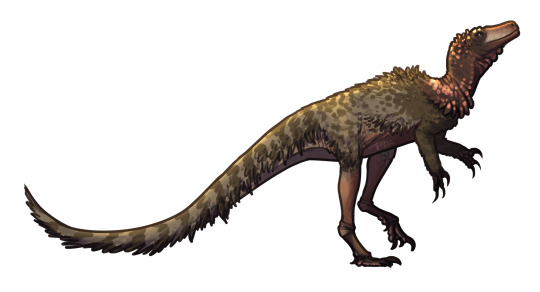
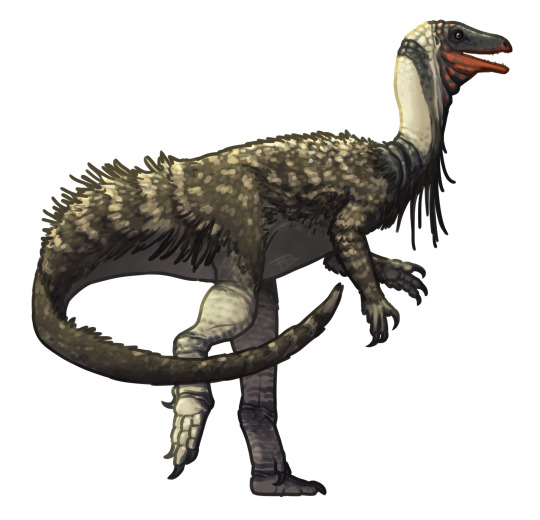
Factfiles:
Gnathovorax cabreirai

Artwork by @i-draws-dinosaurs, written by @i-draws-dinosaurs
Name meaning: Cabreira’s devouring jaw (in honour of the discoverer Dr. Sérgio Furtado Cabreira)
Time: 233.23 million years ago (Carnian stage of the Late Triassic)
Location: Santa Maria Formation, Brazil
Gnathovorax is a herrerasaurid dinosaur named in 2019, and we shoved it into the sauropodomorph section just so that we would have somewhere to put it. It’s known from an impressively complete skeleton with almost all bone elements represented, including a beautiful skull! It’s also the first herrerasaurid named in a long time, and its discovery has helped reignite the study of this weird group of guys. Where herrerasauridae fits into dinosauria is, simply put, A Mess. They had been considered the earliest theropods for decades, but more recent work like the kinda still controversial ornithoscelida hypothesis placed them as the sister group of sauropodomorphs, and further analyses even placed them outside of dinosaurs entirely! Thankfully, Gnathovorax seems to have helped resolve some of those issues with a new-new analysis of herrerasaurid relationships, that puts them as basal saurischians, neither sauropodomorphs or theropods.
Mbiresaurus raathi

Artwork by @i-draws-dinosaurs, written by @i-draws-dinosaurs
Name meaning: Raath’s reptile from Mbire (after the Mbire district of Zimbabwe, and in honour of palaeontologist and discoverer Michael Raath)
Time: ~ 230 million years ago (Carnian stage of the Late Triassic)
Location: Pebbly Arkose Formation, Zimbabwe
There was once a time… before titanosaurs… before diplodocids… before any sauropod… when sauropodomorphs were simply Just Some Little Guy. And that is where Mbiresaurus, oldest African dinosaur ever found, comes in!
Mbiresaurus was named in 2022 from Zimbabwe, and is the only dinosaur yet named from the Pebbly Arkose formation. It’s known from a beautifully complete skeleton that has all the features of a classic Early Dinosaur. It is small, has long gangly legs and arms, and a lil head with vaguely pointy kinda multipurpose teeth. The fact that all the wild diversity and enormous size of the sauropods came out of something like this is hard to imagine, but evolutionarily step by step these little scampery dudes would work their way up!
DMM Round One Masterpost
#dmm#dinosaur march madness#dmm round one#dmm: rising stars#palaeoblr#dinosaurs#paleontology#bracket#march madness#polls#gnathovorax#mbiresaurus
112 notes
·
View notes
Text
Africa's most established dinosaur found in Northern Zimbabwe

A group of scientistss has found another early skeleton that is up to this point, the most seasoned dinosaur skeleton at any point tracked down in Africa. It is assessed Mbiresaurus raathi was a long-necked dinosaur that was around 6 feet in length, gauging somewhere in the range of 10 and 30 kilograms. An alumni understudy at Virginia Tech found the generally unblemished fossil in Northern Zimbabwe and it was uncovered more than two dives in 2017 and 2019.Read More...
1 note
·
View note
Text
Mbiresaurus raathi Griffin et al., 2022 (new genus and species)

(Select bones and schematic skeletal of Mbiresaurus raathi [scale bars = 1 cm for most individual bones; 1 mm for “s”, an individual tooth; and 20 cm for the skeletal], with preserved bones in white, from Griffin et al., 2022)
Meaning of name: Mbiresaurus = Mbire lizard [in Greek]; raathi = for Michael Raath [South African paleontologist]
Age: Late Triassic (Carnian)
Where found: Pebbly Arkose Formation, Mashonaland Central, Zimbabwe
How much is known: Skeletons of at least two individuals, one of which is nearly complete. Some isolated femora (thigh bones) from the same region may also belong to this taxon.
Notes: Mbiresaurus was an early sauropodomorph. Although sauropodomorphs famously include gigantic, long-necked quadrupeds, the earliest members of this group, including Mbiresaurus, were relatively small (less than 2 m long), bipedal dinosaurs.
Other than the controversial Nyasasaurus, which is only known from fragmentary remains, Mbiresaurus is the oldest known dinosaur from Africa, and possibly one of the oldest known dinosaurs in the world. Dinosaur fossils of similar age have otherwise only been found in South America and India. The fossil sites where such early dinosaurs were discovered were all situated at high latitudes in the Southern Hemisphere during the Late Triassic, which may suggest that the oldest dinosaurs were restricted to this geographic region.
Reference: Griffin, C.T., B.M. Wynd, D. Munyikwa, T.J. Broderick, M. Zondo, S. Tolan, M.C. Langer, S.J. Nesbitt, and H.R. Taruvinga. 2022. Africa's oldest dinosaurs reveal early suppression of dinosaur distribution. Nature advance online publication. doi: 10.1038/s41586-022-05133-x
117 notes
·
View notes
Text
Qual'è il più antico dinosauro mai trovato?

Scoperto il più antico dinosauro africano. Dimostra che il clima condizionò la diffusione dei primi dinosauri. Scoperto in Zimbabwe il più antico dinosauro africano, vissuto circa 230 milioni di anni fa: chiamato Mbiresaurus raathi, era un parente dei sauropodi caratterizzato da un lungo collo.
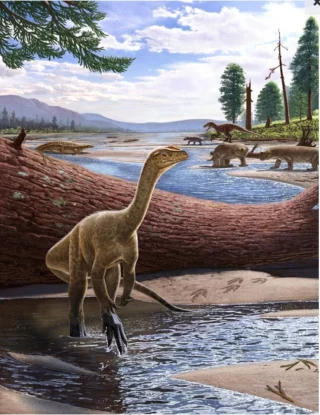
Ricostruzione artistica del più antico dinosauro africano, Mbiresaurus raathi (fonte: A. Atuchin) Alto circa un metro, pesava meno di 30 chili, aveva una testa piccola, denti triangolari seghettati e si muoveva su due zampe. Il suo fossile, quasi completo, colma una lacuna geografica nella documentazione fossile dei dinosauri più antichi, dimostrando che la loro dispersione è stata condizionata da fattori climatici. Lo indica lo studio pubblicato su Nature da un gruppo internazionale di paleontologi guidati dal Virginia Tech. Il fossile di Mbiresaurus raathi è stato trovato insieme ai resti di altri animali del Tardo Triassico, come un dinosauro herrerasauride, antichi parenti dei mammiferi come il cinodonte, rettili corazzati come gli aetosauri e i rettili rincosauri. Simili depositi di fossili della stessa epoca erano già stati trovati in Sud America e in India. "I dinosauri più antichi vengono più o meno dalle stesse antiche latitudini lungo la cintura climatica temperata meridionale che si trovava a circa 50 gradi sud", spiega il ricercatore Christopher Griffin. Proprio per questo motivo, il suo team ha deciso di condurre degli scavi nel nord dello Zimbabwe, nelle aree che rientravano in quella antica fascia climatica, colmando così il gap tra il sud del Brasile e l'India. Per verificare l'ipotesi che i primi dinosauri fossero davvero confinati da vincoli climatici nel sud dell'antico supercontinente Pangea, i ricercatori hanno condotto uno studio statistico sull'albero evolutivo dei dinosauri, scoprendo così che la loro dispersione verso nord è avvenuta in corrispondenza di un periodo di forte umidità a livello globale (Evento Pluviale Carnico) che ha rotto le 'barriere' climatiche. Read the full article
#africa#africano#alberoevolutivo#clima#dinosauro#EventoPluvialeCarnico#evoluzione#fossilefossili#Mbiresaurusraathi#paleontologia#Zimbabwe
0 notes
Text
Ecco Mbiresaurus raathi, il più antico dinosauro africano conosciuto
Ecco Mbiresaurus raathi, il più antico dinosauro africano conosciuto
Ricostruzione in vita di Mbiresaurus raathi (in primo piano) con gli altri animali che vivevano nello Zimbabwe nello stesso periodo sullo sfondo: due rhynchosauri (davanti a destra), un aetosauro (a sinistra) e un dinosauro ererasauride che insegue un cinodonte (dietro a destra). Mbiresaurus raathi visse nell’attuale Zimbabwe durante l’età carnica del Triassico, circa 230 milioni di anni…

View On WordPress
0 notes